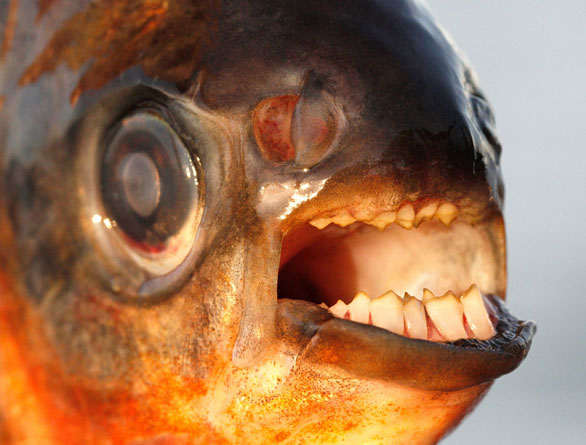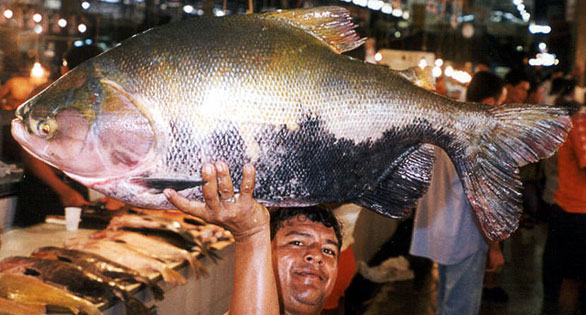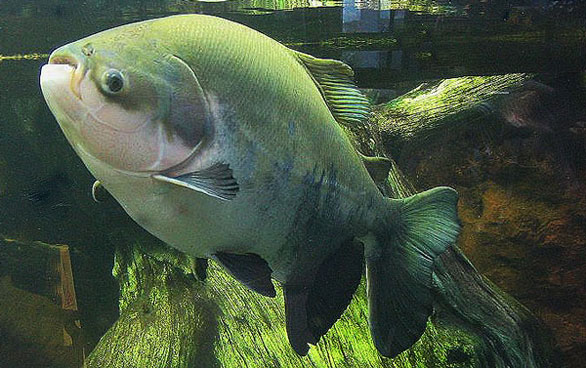
Pacu caught by a fisherman in the waters between Denmark and Sweden in summer, 2013. Image: Henrik Carl/University of Copenhagen.
Scandinavian scientists issue Pacu Warning to male skinny dippers
Summer months, often the doldrums for hard news, annually bring out shark-attack scare stories and flashbacks to hair-raising scenes in the movie JAWS, but for northern European swimmers the mid-summer chill this year has been provided by a herbivorous fish caught in the strait of Oresund between Denmark and Sweden.
In early August, fisherman Einar Lindgreen brought ashore a fish he had never before encountered, and, thinking it might be a piranha, sent it to the Natural History Museum of Denmark at the University of Copenhagen.
Ichthyologists were quick to identify the specimen as a pacu, a mostly herbivorous tetra that can attain massive sizes and that periodically turns up far from its native range in South America. Aquarists are usually blamed for releasing pacus notorious for outgrowing most home-scale tanks.
While reassuring the public that piranhas were not swimming free in Scandinavian waters, the museum scientists were not shy about warning male Danes and Swedes to think twice about skinny dipping where there was a possibility of more pacu lurking. “Anyone choosing to bathe in the Oresund had best keep your swimsuits well tied,” they advised.
Pacu, the biologists pointed out, have been nick-named “nutcracker fish” and “ball-cutters” for their reputed history of attacking and biting human testicles. Unverified reports from Papua New Guinea blame an introduced population of pacu for two fatal attacks on men who were castrated while wading in the Sepik River and bled to death.

“Extreme angler” and host of the River Monsters series on Animal Planet, Jeremy Wade theorizes that transplanted pacu may be developing a taste for more than plant matter.
Jeremy Wade’s “Hungry Pacu” Hypothesis
Jeremy Wade, “extreme angler” and host of the Animal Planet show River Monsters, helped etch the tale of the unfortunate Papuans with an episode entitled, The Mutilator. Wade says that the pacu were introduced in large numbers by a government agency in Papua New Guinea in the mid-1990s to provide a new source of protein and a fish prized for its excellent eating qualities. However, the pacu are reported to have seriously upset the local ecosystems, overgrazing native vegetation to the point where the pacu were left ravenously hungry. Wade did catch a 40-pound pacu in the same region where the genital attacks were reported to have taken place.
Esquire Magazine recently interviewed Wade about his encounters with pacu:
Esquire.com: So when you were fishing for them did it make you nervous, knowing their reputation?
JW: I’m in a boat. The thing about the pacus in the Amazon is they’re normally vegetarians. If there’s plenty of their normal diet around, then they’re gonna be happy with that. It eats nuts and seeds that fall from the trees. They have got very powerful jaws and teeth, because some of these nuts are quite hard to crack. Some people say that the teeth look like human teeth, people in the fish world say that the closest thing to them is the teeth of a horse. The problem in Papua New is if there isn’t the normal food they’ll figure something out.
Esquire.com: So you think they’re attracted to testicles because they resemble nuts?
JW: I think if they’re hungry enough! For instance, lets look at “why do fish bite the parts that they bite?” A fish with a big mouth, like a catfish, they’ve been known to bite people’s legs. Normally not because they’re hungry, but because they’re protecting a nest or something like that. But piranhas, for example, are known to first bite the nose or ears, places where they can get some purchase. They’re not going to get purchase on a flat surface. They need a protrusion for them to get their mouths on, as they’ve got a very small mouth. That’s why I think if the pacu is really hungry… The other thing is, visibility is often not very good in fresh water. So if a fish bites something, a part of the body, it doesn’t actually always realize that it’s part of a body. It just sees something sort of waving around in front of it.

Pacu, Colossoma macroponum, also known as the Cachama, for sale in the Manaus Fish Market, Brazil. Image: Thorke Ostergaard/Wikipedia.
AMAZONAS Magazine‘s translator Stephan M. Tanner, Ph.D. was also interviewed by the Discovery Channel in the wake of the Scandinavian pacu stories and he said that fears of pacu proliferating in northern waters are extremely overblown.
“It’s a plant eater,” said Stephan Tanner, an editor and translator at Amazonas Magazine. “If you release it in Denmark, it won’t survive the winter. If you release it in Florida, it may swim for a long time. Will it reproduce? That’s another question.”
Meanwhile, another pacu measuring a foot in length was hooked by a fisherman in the River Seine in Paris in early September, fueling yet more lurid headlines and fear among ichthyophobes. Screamed The Mirror, of London, “Testicle-eating ‘ball-cutter’ fish could be heading for UK after being spotted in France.”
A number of different species carry the common name “pacu,” and the two most recent European catches have not yet been positively identified. All are primarily herbivores, although they will also consume insects and smaller fish.
Reports of pacu caught in U.S. waters are commonplace. Wikipedia lists citations for catches in some 32 states: “Discoveries in the United States have been reported in Alabama, Arizona, Arkansas, California, Colorado, Georgia, Iowa, Idaho, Illinois, Indiana, Kentucky , Maine, Maryland, Massachusetts, Michigan, Minnesota, Missouri, Missouri, Nebraska, New Hampshire, New York, North Carolina, North Dakota, Ohio, Oklahoma, Pennsylvania, South Carolina, Texas, Utah, Washington, Wisconsin, and Wyoming.
State wildlife authorities typically advise home aquarists who wish to get rid of overgrown pacu to cut the heads off the fish and dispose of them as garbage. However, Habitattitude, a U.S. national initiative led by the Aquatic Nuisance Species (ANS) Task Force, recommends humanely disposing of the fish through a veterinarian or pet retailer, returning them to retailers, or donating them to a local aquarium society, school, or aquatic business.”
REFERENCES
Amazonas Magazine. Species Profile: Pacu.
Wade, Jeremy. The Nutcracker Fish, Animal Planet. Original air date: 10 April 2011.
Joiner, James. Jeremy Wade Weighs In On The Nutcracker Fish. Esquire.com
http://www.esquire.com/blogs/news/jeremy-wade-on-the-nutcracker-fish
Niler, Eric. Testicle-Munching Fish: All That Dangerous? Discovery News, August 13, 2013.







In the picture at Manaus Fish Market it is a TAMBAQUI specimen (as writen JUST in the cientific name) and not a PACU – Piaractus mesopotamicus. The tambaqui does not receive the pacu name anywhere i know. I think things should be clear.
Besides that, as a brazilian sportfisherman, aquarist and veterinary, those attacks should be real rare as I never heard anything about it here, nor in the amazon area or the pantanal area, where the pacu lives, and I am used to be. Even in fish breeding pools plenty of pacus, the people swins here with no stress and no occurrence known by myself. Those kind of information should be meticulous not to scare errounesly people. Best regards.
Thanks for these great insights. We should point out that this species carries dozens of common names, many of which include the name Pacu. You might find this list from Fishbase interesting – http://www.fishbase.org/comnames/CommonNamesList.php?ID=263&GenusName=Colossoma&SpeciesName=macropomum&StockCode=277